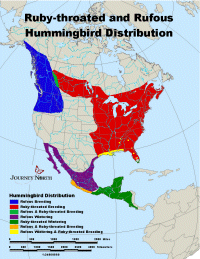| Please
Report Your Sightings! |
Variable winds and rain brought little movement early last week. Winds from the south will bring more hummers and other migrants from the Tropics in the coming week. This week it's all about habitat. What kinds of sun-driven events need to take place before you can sustain a hummingbird? How far away are the hummers from your feeder? Use your map and math skills to predict when you'll see your first hummer.
Today's Report Includes:
- Highlights, Maps, and Questions
- Sun-Driven Events: What Do Hummers Need?
- Predict: When Will Your Hummer Arrive?
- Getting Started: This Week's Hummingbird Resources

What's different about this bird?
Look again...
Highlights:
FOY
Means "Spring!"
"I saw our first rufous hummingbird of the season in West Seattle.
He was beautiful! Happy Spring, Everyone!" For many of the people
spring doesn't officially arrive until they see their first hummingbird
(FOY—First of the Year).
Rain and cold along the Gulf Coast as the winds swung around from the north. Harlan Aschen, from the Gulf Coast of Texas, suggests that new migrants "stack up" and wait to continue migration until the wind is right. Later in the week winds shifted and the southerly winds helped the earliest ruby-throated hummingbirds make their way north across more borders. Rubythroats have now landed in 14 states! Can you name all of them? Observers throughout the South continued to report loads of newcomers moving up from their wintering grounds.
Rain and cold in the Northeast put a halt to the rufous migration for the past week. Check out this week's map question handout to dig a little further into weather and migration.
The coming
week should be better for migration. Much of the country has clear skies
and southerly winds. That means migrants will be able to arrive from the
tropics without any difficulties, and those that are here can make some
progress north.
Seventy-four new rubythroat sightings came in last week. How have your predictions matched the prediction chart of where rubythroats have landed, and when?
"We had two males show up at are house today and they feed till dark!" reports a Journey North citizen scientist. These newly arriving migrants are feeding frantically after their long journeys. What else are observers saying about that? Read on:
 Distribution Map |
||
| Rufous
|
Ruby-throated
|
|
| Handouts:
Today's Hummingbird Map Questions Rufous Questions Rubythroat Questions |
||
All seasonal changes – temperature, plant growth and life cycles, animal migrations, and so on – are driven by shifts in the amount of available sunlight (daylength or photoperiod) and its intensity (related to the angle at which it strikes the Earth).
Think about the chain of sun-driven events that must occur before hummingbirds can find their way to your schoolyard. Study the photographs and think about all you've learned about hummingbirds. Then use what you have learned to predict when you'll spot your FOY (First of the Year)!

How close to you is the nearest reported one will arrive? Try finding your nearest hummer on our maps. Next, measure how far it is from you! Here's what you'll need:
|
 Photo: N.O. Smith |
The Next Hummingbird Migration Update Will Be Posted on April 7, 2010.






